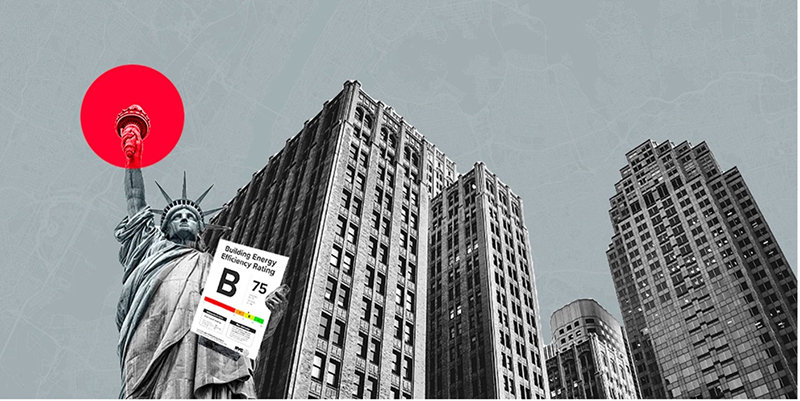


Climate change is knocking. In answer, New York City is turning to its buildings. This makes sense, especially considering that an estimated two-thirds of the city’s greenhouse gas emissions stem from buildings. Emerging to tackle these GHGs is the city’s City of Yes for Carbon Neutrality initiative, which aims to facilitate easier access to green energy technology, particularly for buildings. However, The Big Apple’s plan to target its ever-growing emissions problem requires some major retrofits, fast. And it will need artificial intelligence to facilitate this.

Venturing beyond traditional retrofits
With a skyline packed with over 1 million buildings, a mix of historic structures and modern skyscrapers, the Big Apple is leaning heavily on retrofit incentives to increase energy efficiency and reduce GHG emissions. However, as the Urban Land Institute points out, retrofitting at the scale needed to make a citywide impact is a major logistical and technical challenge. It’s also exceptionally expensive. In fact, it’s estimated that retrofits across North America and Europe could cost in the region of three trillion US dollars.
In this light, AI-driven building optimization presents an appealing complementary tool for old, new, and retrofitted buildings alike; it’s quick to integrate, easy to scale, less disruptive, and cost-effective in the long run. Already, it’s cutting down on project planning and design costs for new builds and optimizing HVAC energy consumption in existing ones. Additionally, its ability to analyze data, predict outcomes, automate building systems, and boost existing energy efficiency through cost-effective connectivity methods make it a valuable ally in retrofitting efforts.
Governments are already aware of this symbiotic relationship. In fact, just recently, the Department of Energy announced a $46 million funding initiative aimed at developing advanced technologies and retrofit practices for more sustainable and resilient buildings.
Why AI fits with retrofits
With these kinds of initiatives, combined with regulations, programs, and incentives such as the NYC Retrofit Accelerator, Property Assessed Clean Energy (PACE) Financing, Local Law 97, NYCEEC financing, and various NYSERDA and Con Edison Energy Efficiency programs, building owners across NYC are compelled to invest in retrofits. Consequently, they’re looking to bolster their efforts with AI, which can make their retrofit decisions more intelligent via data and machine learning and extend the lifespan of their retrofit benefits via autonomous, continuous commissioning.
In addition to these benefits, AI can also:
• Enhance building resilience to climate change: Beyond reducing GHG emissions, AI can play a significant role in making buildings more resilient to the impacts of climate change. AI-driven systems can predict and adapt to extreme weather conditions, ensuring that buildings can withstand and quickly recover from events like heatwaves, storms, and flooding. This resilience is especially critical for a city like New York, where the frequency and intensity of such events are expected to increase due to its geographic location, urban infrastructure, and demographic density.
• Facilitate smart city integration: Retrofitting buildings with AI is a step toward the broader vision of smart cities, where AI-enabled buildings can communicate with each other and city infrastructure to optimize energy use across the city, achieving the ultimate goal of grid interactive buildings at scale.
• Leverage data for continuous improvement: AI’s ability to continuously collect and analyze data allows for ongoing autonomous optimization of building performance, ensuring that the city’s building stock remains at the forefront of energy efficiency and sustainability.
• Support regulatory compliance and reporting: With complex regulations like Local Law 97, AI can simplify compliance for building owners by automatically tracking emissions and energy use, identifying compliance gaps, and even potentially suggesting corrective actions. This support can reduce the administrative burden on businesses and ensure that the city meets its carbon neutrality goals.
• Improve indoor air quality and occupant health: AI can also monitor and control indoor air quality in real-time, reducing pollutants and ensuring a healthier environment for occupants.
Embracing AI for a sustainable future
It’s easy to see why NYC is increasingly deploying AI in its buildings. Its long-term cost-effectiveness, adaptability, and scalability make it the perfect complement to retrofitting projects for old and new buildings alike. Even more evident is the supportive role it can play in initiatives like the City of Yes for Carbon Neutrality, which serves as a model for how AI can be used to combat climate change at an urban scale. Indeed, NYC’s embracing of these kinds of technologies will be central to the success of its retrofitting challenge - and could even turn out to be the key to reaching the city’s goal of carbon neutrality by 2050.
Sam Ramadori is CEO and Jean-Simon Venne is co-founder & CTO of BrainBox AI, Montreal, Canada.
